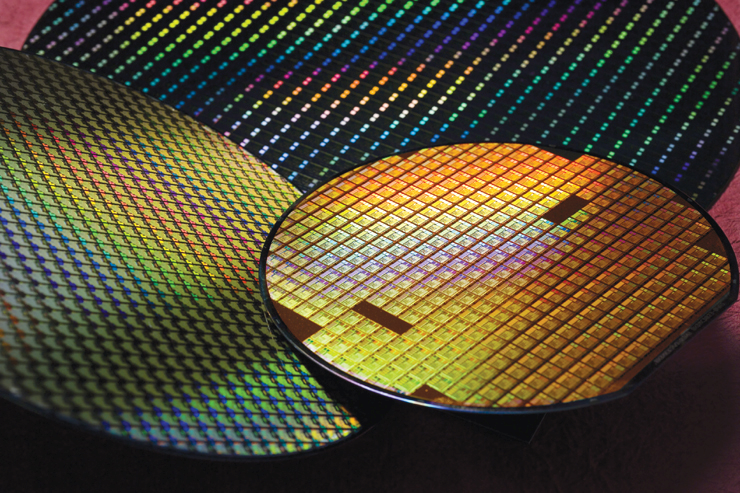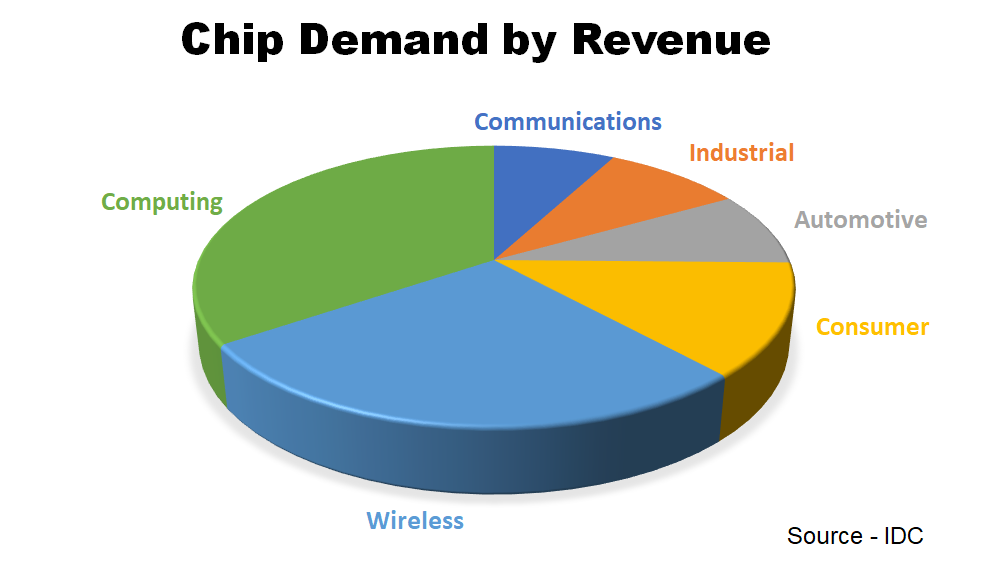Global Chip Shortage

26 December 2021 | Mihir Kavishwar, Adil Khan, Amol Shah
Effect of the shortage
November 2020 was supposed to be an exciting month for gamers. Sony's PlayStation 5 and Microsoft's Xbox Series X and Series S consoles were released just a few days apart. However, both PS5 and Xbox went out of stock almost immediately after their respective launches, disappointing thousands of users who were eagerly waiting to buy these products. Strangely enough, it's December 2021, and a large number of users are still waiting. With online retail stores greeting customers with "product unavailable" and "out of stock" messages, desperate gamers are turning to websites like eBay, where scalpers are selling at more than triple the retail price. One must ask that despite being amongst the biggest technology companies globally, why haven't Sony or Microsoft boosted their production even a year after the launch? It turns out gaming consoles are just the tip of the iceberg. Almost every industry that uses electronic components, be it something as simple as an amplifier, is bearing the brunt of a significant ongoing global chip shortage.
The most brutally hit are the auto manufacturers. Earlier this year, car companies found themselves in a predicament. While an average car comprises about thirty thousand individual components, they were missing one or two, worth perhaps only a couple of dollars. It didn't matter. For just a few missing parts, the entire production had to stop. In the United States, companies like Ford, Honda, Volkswagen, Audi and General Motors shut down many of their factories and sent workers home. We saw a similar trend in India with Maruti Suzuki, Tata Motors, Toyota and Mahindra & Mahindra announcing closures of some of their manufacturing plants. Although it is hard to estimate the exact economic implications, AlixPartners, a global consulting firm, has projected mammoth losses of up to $110 billion for the entire automotive sector, with nearly 3.9 million vehicles of production being lost to the chip shortage this year alone. Despite several new launches keeping consumer interest high, auto sales seemed to decline by about 3% in November 2021, largely attributed to the paucity of critical electronic parts that continues to impact production.
The consumer electronics sector has also been suffering massively in the last few months. During the pandemic, the demand for mobile phones, laptops and PCs shot up. Although the shortage did not severely impact the high end processors, supply of lower value silicon such as chips that are used to derive displays and audio functions has been impacted. Apple executives have already warned that the shortage could impact production of the latest iPhones and Mac devices.
Apart from big companies, small scale startups and research centers are also severely affected since the manufacturers typically prioritise bulk orders from big clients over smaller orders. The shortage was felt even in our department - it posed some challenges when we needed to get boards made at WEL last semester for our online lab courses.

How does the global supply chain work?
Semiconductor chips today are highly miniaturized electronic circuits consisting of active devices like transistors, diodes and passive devices such as capacitors and resistors apart from the metallic interconnections that are used to connect them. They are layered on a thin wafer of some semiconductor substrate material, typically silicon. These chips are extremely tiny and can pack more than a billion electronic devices in an area on the order of a few square millimeters.
The supply chain for semiconductors is highly globalized with even individual companies having manufacturing and design facilities in multiple countries around the world. At a high level, it comprises three broad steps, namely Integrated Circuit Design, Wafer Fabrication and Assembly & Testing. The industry today operates majorly in a foundry model, with fabless semiconductor companies (such as Qualcomm, Nvidia) involved in the design of ICs, and these in turn outsource the manufacturing to pure play foundries (such as TSMC), which only manufacture devices for other companies. A few companies operate in both areas and are known as integrated device manufacturers (such as Intel, Samsung and Texas Instruments). Adding to these, there is a large supporting ecosystem of specialised equipment manufacturers, raw material suppliers and EDA and core IP vendors.
Design
Designing semiconductor integrated circuits today is a highly complex process - The development cost of a new state-of-the-art system-on-chip (SoC) for a flagship smartphone, which includes the specialized blocks required to process audio, video and provide high-speed wireless connectivity, could be upwards of $1 billion and require multiple years of work effort. In comparison, derivatives that are able to make use of a significant portion of an existing design or new simpler chips that are built for mature technology nodes would have a development cost of just about $20 million to $200 million. To help in integrated circuit design by Fabless companies and IDMs, Electronic design automation (EDA) firms provide a variety of sophisticated software and services for circuit design, simulation, physical layout and design verification. The major EDA players today are Cadence, Synopsys and Mentor Graphics. In addition to these, Core IP (intellectual property) suppliers provide standard and reusable component designs called “IP blocks” with a defined interface and functionality to enable multiple design firms to incorporate them into their integrated circuit layouts with minimal modification required.
Wafer Fabrication (front-end manufacturing)
Specialized manufacturing facilities called "fabs" or fabrication plants, print or fabricate the nanometer scale integrated circuits from the chip design onto the top of actual silicon wafers. Each wafer, usually sized around 300 mm in diameter, contains many individual chips of the same design. The number of chips on a single wafer can vary between a few hundreds to hundreds of thousands depending upon whether it is a complex chip such as a desktop processor or a small chip for performing simple functions. The size of individual device dimensions (such as a transistor) on an integrated circuit has been continuously shrinking since about 50 years, with state-of-the-art manufacturing today at the 5 nm technology node. However, in recent years, the technology node length has had no relation to any actual physical feature on the device, instead indicating a generational improvement in the chip such as higher transistor density. Depending on the specific design complexity, there are about 400 to 1,400 steps in the entire fabrication process of semiconductors including oxidation, lithography, etching, doping and metal deposition. The time taken for semiconductor fabrication, termed as the cycle time, is on an average about 12 weeks, but it can even take up to 20 weeks for the more advanced processes.
Assembly and testing (back-end processing)
Back-end processing is typically carried out by OSAT (Outsourced Semiconductor Assembly and Testing) firms where the multiple chips on a single silicon wafer produced by fabs are converted and packaged into individual chips that can be readily assembled into actual electronic devices. Silicon wafers are first sliced into individual chips, following which they can be diced, packaged and encased in a protective epoxy resin shell. The package gives mechanical protection to the semiconductor die, provides for external circuit connections and may also help in heat dissipation. These chips then need to be rigorously tested for functionality before being shipped to electronic device manufacturers and finally be used in end products.

What led to the shortage?
A wide array of reasons have been given for one of the most widespread chip shortages in history, ranging from the classical economic problem of supply and demand mismatch to a recent drought in Taiwan. The cause which is most often cited is the industry wide miscalculation of semiconductor demand, especially going into the COVID-19 pandemic. But the roots for the crisis had taken place well before the pandemic and the imposition of widespread lockdowns. In 2018, a full-blown trade war started between the United States and China, leading to cascading effects in the semiconductor production line starting from the shortage of raw materials. A year later, the United States began a series of gradual restrictions on Chinese tech giant Huawei cutting it off from the global semiconductor ecosystem. This resulted in Huawei racing against deadlines and stockpiling semiconductors before each new ban came into effect. Meanwhile, another trade war erupted, albeit on a smaller scale, between Japan and Korea. Japan, one of the largest producers of fluorinated polyimide, resist and hydrogen fluoride, all three crucial chemicals for semiconductor production, announced in July 2019, that it would restrict sales of these materials to South Korea.
Enter the COVID pandemic, and the chip manufacturing companies were suddenly faced with lockdowns and disruptions in production and also the possibility of subdued demand due to lower consumer spending. However, this turned out not to be the case as within a few months, orders from consumer electronics companies and cloud service providers skyrocketed. As work from home became the norm, the demand for devices like laptops, smartphones and routers surged. On the other hand, companies in the automotive and industrial sectors, faced with a rather gloomy outlook, began cutting back on chip orders. However, this was short lived as demand for cars recovered faster than expected in many parts of the world, ostensibly due to people avoiding public transportation. Already overloaded with orders from consumer electronics firms, the automotive industry orders were pushed to the back of the queue and this resulted in increased lead times for supply. As the effects of the shortage were felt more and more, companies started stockpiling orders in anticipation, sending ripples up the supply chain and causing more and more shortages due to the bullwhip effect.
Isolated events like fire at a PCB substrate manufacturer in Japan and the closure of several fabs including those of Samsung, NXP and Infineon in Texas due to a winter storm further exacerbated the shortages. In 2021, Taiwan faced one of its most severe droughts in more than half a century. Semiconductor production requires high amounts of ultra pure water, and Taiwan even decided to prioritize water for chip manufacturing over rice farming in its national and global interest. However, all of these events threw the supply-demand equilibrium into complete disarray, with the demand far outpacing the supply. Companies and governments around the world announced huge investments in fabrication plants to get over the chip shortage, however these measures can only have an effect in the long term as setting up a new fab takes around three years. Moreover, the shortage is spread across the spectrum, including in 40 nm and larger nodes whose chips are widely used in the automotive industry. There is insufficient incentive for setting up new fabs at these older nodes, even at the peak of the chip shortage, due to huge capital costs and insufficient profitability on legacy node technologies in the long run. In the current scenario, the chip shortage is estimated to last well into 2022 and possibly beyond that, however with newer fab capacity coming into operation by then, there is hope of some light at the end of the tunnel.
Solutions and India’s role for the future
The shortage was an eye-opener for many countries around the world to work towards curbing the growing gap between supply and demand for semiconductor chips, and also to reduce the global reliance on a multitude of countries to create even a basic single chip. Many countries and multinational blocs like the European Union have started working on plans to set up indigenous fabs to reduce reliance on foreign countries. Long-term solutions include increasing the production facilities; however, setting up new fabs typically takes many years.
The Government of India floated an expression of interest (EoI) in December 2020 to set up a commercial semiconductor fab in India, with the government being open to negotiating new incentives for fabs apart from the already fixed ones. It was reported by the Business Line that over 20 semiconductor manufacturing and designing companies submitted their expression of interest proposals. Tata Sons recently stated that they are looking at the possibility of entering into semiconductor manufacturing in India. It was reported in various media outlets that they are currently in talks with three state governments and scouting for land to set up an outsourced semiconductor assembly and test (OSAT) plant by late 2022.
On 15th December 2021, almost a year after floating the EoI, the Union Cabinet approved a ₹76,000 crore (> $10 billion) program for the development of semiconductor and display manufacturing ecosystem in India. It promises to usher in a new era in electronics manufacturing by providing a globally competitive incentive package to companies in semiconductors and display manufacturing as well as design. As per the statement released by the Ministry of Electronics and Information Technology (MeitY), the program aims to provide attractive incentive support to companies / consortia that are engaged in silicon semiconductor fabs, display fabs, compound semiconductors / silicon photonics / sensor (including MEMS) fabs, semiconductor packaging (ATMP / OSAT) and semiconductor design. The government promised to extend fiscal support of up to 50% of the project cost to eligible applicants for setting up commercial semiconductor and display fabs in India. It also announced that MeitY would take requisite steps for the modernization and commercialization of the Semi-conductor Laboratory (SCL). In order to drive the long-term strategies for developing a sustainable semiconductor and display ecosystem, a specialized and independent nodal agency, “India Semiconductor Mission (ISM)” will be set up. With several incentive-based schemes as a part of the program, the Government of India committed support of ~₹2,30,000 crore ($30 billion) in total to position India as a global hub for electronics manufacturing with semiconductors as the foundational building block.

We talked to Prof. Udayan Ganguly, who is part of a team from IIT Bombay commissioned by the government to prepare a detailed project report on the setting up of an RnD semiconductor foundry in India. He emphasized on the need of a semiconductor ecosystem as a precursor for commercial fabs. As per him, the talent and human resources in India are the key reasons why any company would want to invest and build fabs in India. There is a thriving and well established fabless design ecosystem in our country, however the same is not true for chip manufacturing. He specified that setting up a fab ecosystem is not a short term project, but is akin to a 30 year long space program. As companies usually work on a shorter time horizon, government incentives are necessary in order to incubate such an ecosystem. However, once a fab ecosystem is developed, it can be extremely beneficial for the country; in terms of being talent intensive, providing high quality employment, being highly profitable and also being at the cutting edge of technology. Prof. Udayan listed the lack of a market for semiconductor chips in India as being one of the key challenges. As of now, the Indian industry has been mostly limited to purchasing pre-finished goods like printed circuit boards which come later in the value chain instead of individual semiconductor chips. He suggested that one of the ways to get around this is inviting foreign semiconductor manufacturers who already have a well established market to come and set up fabs in India. We need to prepare the field for semiconductor fabrication companies to come here and provide them an edge over other competing countries. He said that the sweet spot right now for India might be in more mature technology nodes like 28 nm and above instead of leading edge nodes like 14 nm and below, as the 28 nm node requires a comparatively lower capital investment while still covering about 60% of the market.
All in all, with the ubiquitousness of semiconductors and the growing demand for electronic devices in India and globally, it becomes all the more important to have a thriving semiconductor manufacturing ecosystem in India that can compete with the world. We hope that the recent initiatives of the government in this regard bear fruit and emerge successful.
References - Strengthening the Global Semiconductor Supply Chain in an Uncertain Era, Report by BCG and SIA, April 2021
Image Credits - TSMC, David Carron